A windmill is a machine that converts the energy of the wind into other, more useful forms like mechanical energy.
Early windmills were designed to grind grain and pump water. Later on, windmills were designed to generate electricity. Electricity-generating windmills are commonly referred to as wind turbines or wind generators. Water pumping windmills are generally referred to as such or simply as windmills.
Windmill vs. Wind Turbine
Wind energy was also extremely important to railroads in the West. Windmills were often used to fill water tanks along tracks to supply the steam engines of locomotives.
In the 1920s through the early 1950s, many Plains farmers also installed wind turbines to generate electricity. The turbines powered lights and all their appliances, many of which were ordered from the Sears catalog - including electric toasters, washing machines and radios. Radios were particularly important, as they allowed farmers and their families to keep in touch with the world.
Unfortunately, the use of water-pumping and small wind-powered electric generators began to decline in the United States in the late 1930s. Their demise was due in large part to America's ambitious Rural Electrification Program. This program, which began in 1937, was designed to provide electricity to rural America. As electric service became available, wind-electric generators were mothballed.
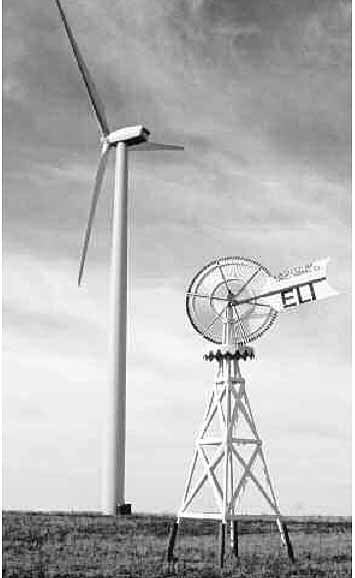
Fig. 1.1: The Old and the New. Water-pumping windmills like the one in the
foreground were once common in the West and Midwest. The technology hasn't
changed in 100 years. In the distance is a modern commercial wind turbine
that generates electricity to power cities and towns.
In fact, local power companies required farmers to dismantle their wind generators as a condition for providing service via the ever growing electrical grid. The electrical grid, or simply the grid, is the extensive network of high-voltage electrical transmission lines that crisscross nations, delivering electricity generated at centralized power plants to cities, towns and rural customers. A key advantage of the grid was its ability to provide virtually unlimited amounts of electricity to customers.
Unfortunately, rural electrification drove virtually all of the manufacturers of windmills and wind-electric generators out of business by the early 1950s. However, in the mid-1970s, wind energy made a resurgence as a result of intense interest in energy self-sufficiency in the United States, stimulated principally by back to-back oil crises in the 1970s that resulted in skyrocketing oil prices and a period of crippling inflation. Generous federal incentives for small wind turbines, incentives from state governments, and changes in US law that required utilities to buy excess electricity from small renewable energy generators helped stimulate the comeback.
Soon thereafter, however, wind energy took a nosedive.
Conservation and energy efficiency measures in the United States and new, more reliable sources of oil drove the price of oil and gasoline down. Federal and state renewable energy tax incentives disappeared as a result of a precipitous decline in America's concern for energy independence. As a result, all but a handful of the small wind turbine manufacturers went out of business.
In the 1990s, commercial and residential wind energy staged another comeback as a result of many factors, among them rising oil prices, global awareness of the decline in world oil production, an increase in the cost of natural gas, and growing concern for global climate change and its impacts.
Because of these factors, many believe that this time around, wind energy is here to stay. Much to the delight of renewable energy advocates, large commercial wind farms have begun to appear in numerous countries, most notably the United States, Germany, Spain and Denmark. These facilities produce huge amounts of electricity and are changing the way the world meets its energy needs. Today, wind-generated electricity is the fastest growing source of energy in the world (___ 1.2).
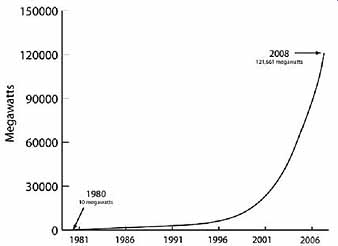
Although commercial wind farms are responsible for most of the growth in the wind industry, smaller residential-scale wind machines are also emerging in rural areas, supplying electricity to homes, small businesses, farms, ranches and schools (___ 1.3).
Most of the small-scale wind turbines "feed" the excess electricity they produce back onto the electrical grid.
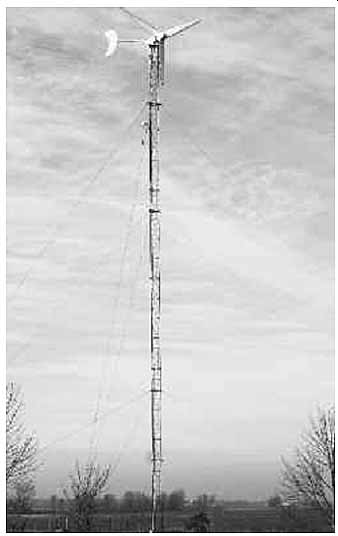
Fig. 1.3: Small Wind Turbine on Tower. This ARE442 wind turbine installed
at Mick's house is mounted on a guyed lattice tower. Maintenance is performed
by climbing the tower.
World Wind Energy Resources
Wind energy is clearly on the rise and could become a major source of electricity in years to come because wind is widely available and often abundant in many parts of the world. Significant resources are found on every continent. Tapping into the world's windiest locations could theoretically provide 13 times more electricity than is currently produced worldwide, according to the Worldwatch Institute, a Washington, DC-based nonprofit organization.
==Rated Power in Watts or Kilowatts==
Wind turbines are commonly described in terms of rated power, also known as rated output or rated capacity. Rated power is the instantaneous output of the turbine (measured in watts) at a certain wind speed (called the rated speed) at a standard temperature and altitude. The rated power of small wind turbines falls in the range of 1,000 to 100,000 watts. One thousand watts is one kilowatt (kW). Large wind turbines include all of those turbines over 100 kilowatts.
Most larger turbines, however, are rated at one megawatt or higher. A megawatt is a million watts or 1,000 kilowatts.
It is important to note that wind turbines do not produce their rated power all of the time, only when they're running at their rated wind speed. As noted in Section 5, while rated power is commonly used when describing wind turbines, it is one of the least useful and most misleading of all parameters by which to judge a wind generator.
==
In North America, wind is abundant much of the year in the Great Plains and in many northern states. It is also a year-round source of energy along the Pacific and Atlantic coasts and the shores of the Great Lakes. Tapping into the windiest locations in the United States, for example, in North and South Dakota could pro duce enough electricity to supply all of the nation's electrical needs.
Proponents of wind energy estimate that wind could eventually provide at least 20 to 30 percent of the electricity consumed in the United States and other countries.
Proponents of renewable energy envision a future powered by wind and a host of other clean, affordable renewable energy resources, among them solar energy, biomass, geothermal energy, tidal energy, wave energy and ocean currents (___ 1.4). The Pros and Cons of Wind Energy Wind is a seemingly ideal fuel source that could ease many of the world's most pressing problems. Like all energy sources, small wind power has its advantages and disadvantages. Let's look at the down sides of small wind systems first.
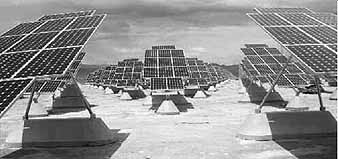
Fig. 1.4: Solar Array. In a renewable energy future, large solar electric
installations like this one will supplement electricity produced by other
renewable resources, including wind, hydropower and biomass.
Disadvantages of Wind Energy
Small wind's disadvantages are few and often grossly exaggerated or only perceived problems. They include wind's variability, bird mortality, aesthetics, property values and unwanted sound. Some people are concerned about wind being more site specific than solar electricity. There's even concern about ice falling from turbines after ice storms and interference with radio and televisions signals.
Variability and Reliability of the Wind
Perhaps the most significant "problem" with small wind is that the wind does not blow 100 percent of the time in most locations.
Wind is a variable resource, to be sure. It's not available 24 hours a day like coal or oil. In fact, a wind turbine may operate for four days in a row, producing a significant amount of electricity, then sit idle for two days - or a week.
Wind resources vary seasonally, too. In most locations, winds are typically strongest in the fall, winter and early spring, but decline during the summer. Wind even varies during the course of a day.
Winds may blow in the morning, die down for a few hours, then pick up later in the afternoon and blow throughout the night.
Even though wind is a variable resource, it is not unreliable. Just like solar energy, you can count on a certain amount of wind at a given location during the year. With smart planning and careful design, you can design a wind system to meet your electrical needs.
Wind's variable nature can be managed to our benefit by installing batteries to store surplus electricity in off-grid systems. The stored electricity can power a home or office when the winds fail to blow.
Surplus electricity can also be stored on the electrical grid in many systems. Thus, when a wind-electric system is producing more power than a home or business is using, the excess is fed onto the grid. In times of shortfall, electricity is drawn from the grid.
Wind's variable nature can also be offset by coupling small wind systems with other renewable energy sources, for example, solar electric systems. Such systems are referred to as hybrid systems.
Solar-electric systems (or photovoltaic [PV] systems) generate electricity when sunlight strikes solar cells in solar modules.
Hybrid systems can be sized to provide a steady year-round supply of electricity. Residential wind-generated electricity can also be supplemented by small gas or diesel generators.
Bird Mortality
One perceived problem with wind power is bird mortality. Unfortunately, this issue has been blown way out of proportion. Although a bird may occasionally perish in the spinning blades of a residential wind machine, this is an extremely rare occurrence.
We're aware of only one instance of a bird kill, when a hawk flew into a small wind turbine. "Because of their relatively smaller blades and short tower heights, home-sized wind machines are considered too small and too dispersed to present a threat to birds," notes Mack Zaprillo in his article, "Wind Turbines and Birds," published by Focus on Energy, Wisconsin's renewable energy program.
The only documented bird mortality of any significance occurs at large commercial-scale wind turbines - but even then, the number of deaths is relatively small. Commercial wind turbines kill an estimated 50,000 birds per year. While this may sound like a lot, this number pales in comparison to other lethal forces, among them domestic cats, automobiles, windows in buildings, and communication towers. All in all, cats are probably the most lethal "force" that birds encounter. Scientists estimate that our beloved cats kill about 270 million birds a year nationwide - though the number is very likely much higher.
Aesthetics
Although many people view small wind turbines as things of great beauty, others contend that they detract from natural beauty.
Ironically, those who find wind turbines to be unsightly often ignore the great many forms of visual blight in the landscape, among them cell phone towers, water towers, electric transmission lines, radio towers and billboards. To be fair, there are differences between a wind tower and common sources of visual pollution. For one, a wind turbine's spinning blades call attention to these machines.
Another is that we've grown used to the ubiquitous electric lines and radio towers. As a result, people often fail to see them anymore.
Given the opportunity to oppose a structure in their "viewshed" (for example, at a public hearing that may be required for permission to install a residential wind system) neighbors will often speak up in opposition. If you need to apply for permission to install a turbine on a tall tower, you may encounter this problem. We'll talk about ways to address this in the last section.
Proximity to Homes and Property
Values
Critics raise legitimate concerns when it comes to the placement of wind machines near their property. Although most of the issues over proximity have been raised by individuals and groups that oppose large commercial wind farms, residential systems can also cause a stir among neighbors. Some may be concerned about aesthetics. Others may worry about safety.
To avoid problems, we recommend installing machines in locations out of sight and hearing of neighbors. Safety concerns are typically related to tower collapse - an extremely rare event that is always the result of bad design and improper installation. Even though homeowner's insurance should cover damage to individuals and property, it is best to place a wind turbine and tower well away from your neighbors' property lines.
Unwanted Sound
Opponents of wind energy and apprehensive neighbors sometimes voice concerns about unwanted sound, a.k.a. noise, from residential wind machines. Small wind turbines do produce sound, and as the wind speed increases, sound output increases. Sound is produced primarily by the spinning blades and alternators. The faster a turbine spins, the more sound it produces.
You can reduce unwanted sound by selecting a quieter, low-rpm wind turbine rather than a louder, high-rpm wind turbine. If you are concerned about sound, make this a high priority as you shop for a turbine and let your neighbors know you are sensitive to this issue.
Wind turbines have governing mechanisms, systems that slow down the machines when winds get too strong to protect them from damage. Different governing systems result in different sound levels. (We'll discuss this topic in Section 5.) When researching your options, we recommend that you listen to the turbines you're considering buying in a variety of wind conditions, including those that require governing.
To reduce sound at ground level, be sure to mount your turbine on a tall tower. Suitable tower heights, which we'll discuss later, are usually 80 to 120 feet. A residential wind turbine mounted high on a tower catches the smoother and stronger - and hence most productive - winds. This strategy also helps reduce sound levels on the ground because sound dissipates quickly over distance.
Residential (and commercial) wind machines are also much quieter than many people suspect because the sounds they make are partially drowned out by ambient sounds on windy days. Rustling leaves and wind blowing past one's ears often drown out much of the sound produced by a residential wind turbine.
Sound is measured in two ways - by loudness and frequency.
Loudness is measured in decibels (dB). Frequency is the pitch. A low note sounded on a guitar has a low frequency or pitch. A high note has a high frequency. The average background noise in a house is about 50 dB. Nearby trees on a breezy day measure about 55 to 60 dB. Most of today's residential wind turbines perform very near ambient levels over most of their operating range.
Even though the intensity of sound produced by a wind generator may be the same as ambient sound, the frequency may differ.
As a result, wind turbine sounds may be distinguishable from ambient noises, even though they are not louder. You'll hear a swooshing sound. In other words, while the sound of a wind turbine can be picked out of surrounding noise if a conscious effort is made to hear it, home-sized wind turbines are not the noisy contraptions that some people make them out to be.
Site Specific
Yet another criticism of small wind is that it is more site specific - or restricted - than solar energy.
To understand what this means, we begin by pointing out that there are good solar areas and good wind areas. In a good solar region, most people with a good southern exposure can access the same amount of sun. In a windy area, however, hills and valleys or stands of trees can dramatically reduce the amount of wind that blows across a piece of property. Therefore, even if you live in an area with sufficient winds, you may be unable to tap into the wind's energy because of topography or nearby forests or stands of tall trees. That's what critics mean when they say that wind energy is more site specific than solar.
That said, we should point out that solar resources also vary. If you live in a forest in a sunny location, for example, you'll have a lot less solar energy than a nearby neighbor whose home is in a field.
In addition, homeowners can access the wind at less-than-optimum sites by installing turbines on tall towers. Tall towers help you over come topographical and other barriers.
Ice Throw
Like trees and power lines, wind turbines can ice up under certain conditions. Ice falling off the blades is known as ice throw, and is a concern that may arise during zoning hearings on residential wind turbines.
While ice builds up on blades and wind turbine towers during ice storms, it is typically deposited in very thin sheets. When the blades are warmed by sunlight, the ice tends to break up into small pieces, not huge dangerous chunks, and drop to the ground.
Ice buildup on the blades of a wind turbine dramatically reduces the speed at which a turbine can spin. It's a little like trying to drive a car with four flat tires. As a result, ice is not thrown from a turbine, it falls around the base of the tower - just as it does from trees and power lines.
Any prudent person would stay away from the tower base when ice is shed from the blades, as they would from trees or power lines covered with ice warming in the sun. Ice-laden trees are also considerably more dangerous, as branches can and often do break and fall to the ground, damaging power lines, cars and houses. Entire trees can topple as a result of ice buildup.
On the rare occasion that ice builds up on a wind turbine, experienced wind turbine operators shut down their machines until the Sun or warmer temperatures melt the ice since they can't generate electricity spinning at such low revolutions per minute anyway.
Interference with Telecommunications
Some opponents of wind energy raise the issue of interference with telecommunications signals. This is simply not a problem. Turbines for homes and small businesses have small blades that do not interfere with such signals. Moreover, the blades of modern wind turbines are made out of materials that are "transparent" to telecommunications signals. As a result, small wind turbines are often installed to power remote telecommunications sites. Telecommunication equipment wouldn't be installed in such locations if there were a problem with interference.
The Advantages of Wind Energy
Although residential wind turbines and their energy source, the wind, have a few downsides, wind energy is an abundant and renewable resource. We won't run out of wind for the foreseeable future, unlike oil and natural gas.
Small-scale wind energy could also help decrease our reliance on declining and costly supplies of oil - if electricity generated by wind is used to power electric or plug-in electric hybrid cars and trucks, displacing gasoline, which is refined from oil.
Wind energy can also play a meaningful role in offsetting declining US natural gas supplies. In the United States, approximately 18 percent of all electricity is currently generated by natural gas, according to the US Department of Energy. As supplies decline, wind could help ease the crunch, supplying a growing percentage of our nation's electricity.
Wind could even eventually reduce our dependence on nuclear power as well. In the United States, nuclear power plants generate about 20 percent of the nation's electricity. Although wind energy does have its impacts, it is a relatively benign technology compared to conventional sources of electricity. It could help all countries create cleaner and safer energy at a fraction of the environmental cost of conventional electrical energy production. Wind energy can help nations reduce global warming and devastating changes in our climate. Wind can also help homeowners and businesses do their part in solving other costly environmental problems such as acid rain.
Another benefit of wind energy is that, unlike oil, coal and nuclear energy, the wind is not owned by major energy companies or controlled by foreign nations. An increasing reliance on wind energy could therefore ease international political tension. Reducing our reliance on Middle Eastern oil could reduce costly military operations aimed, in part, at stabilizing a region where the largest oil reserves reside.
Wind is also a free resource. The cost of wind is not subject to price increases. A wind- and solar-powered future might be one subject to less inflation. This is not to say that wind energy will be free of price increases. While the fuel itself (the wind) is free, the price of wind generators is likely to increase. That's because it takes energy to extract and process minerals to make the steel and cop per needed for wind turbines and towers. It also takes energy to make turbines and towers and ship and install them. As the price of conventional fuels and raw materials increases, the cost of wind energy also will go up.
Yet another advantage of wind-generated electricity is that it uses existing infrastructure, the electrical grid, and existing technologies. A transition to wind energy could occur fairly seamlessly.
Thanks to generous tax credits and other financial incentives, individuals in rural areas with good wind resources can meet all or part of their energy needs at rates that are often competitive with conventional sources. In remote locations, wind or wind and solar electric hybrid systems can be cheaper than conventional power, which requires the installation of costly electric lines that transport electricity from power plants to end users.
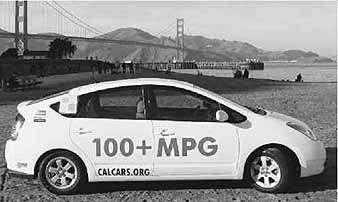
Fig. 1.5: Plug-In Hybrid. Electric cars and plug-in hybrids like the one
shown here are the most promising automobile technologies on the horizon.
They could be powered by electricity from the Sun and wind.
The Purpose of this Guide
This guide's principal focus is on small wind-electric systems - those with rated output ranges from 1 kilowatt to 100 kilowatts.
Most of the turbines we'll be discussing fall in the 1- to 20-kilo watt (kW) range. The blades of small wind turbines (1 to 100 kW) range from 4 feet to 32 feet in length. Small-scale wind systems serve a variety of purposes. The smallest units are generally sufficient to power cabins and cottages; larger small wind turbines power homes and small businesses as well as schools, farms, ranches, small manufacturing plants, and public facilities.
This guide is written for individuals who want a succinct introduction to small-scale wind systems that doesn't require a degree in physics or engineering. My goal was to create a user-friendly guide that teaches readers the basics of wind energy and wind energy systems. This guide is not an installation manual, but it will help you learn about wind if you want to become a wind energy installer or install a wind turbine and tower on your property. It will also help you determine if wind energy is right for you, what your options are, and how much it is going to cost.
When you are done with this guide, you should have a good knowledge of the key components of wind energy systems. This guide will help you when shopping for a wind system or an installer.
You'll also learn about maintenance requirements.
If you choose to hire a professional wind energy expert to install a system - a route we highly recommend - you'll be thankful you've read this guide. The more you know, the more input you will have into your system design, components, siting and installation - and the more likely that you'll be happy with your purchase.
This guide should help readers develop realistic expectations.
Wind energy systems, for instance, require annual inspection and maintenance - climbing or lowering a tower to access the wind turbine to check for loose fasteners and blade damage and , much less commonly, an occasional part replacement. If you are not up for it or don't want to pay someone to climb or lower your tower once or twice a year to check things out, you may want to invest in a solar electric system instead.
Organization of this Guide
After this brief introduction, we turn our attention to the wind itself, the driving force in a wind energy system. In Section 2, you will learn how winds are generated and explore the factors that influence wind flows in your area. We will also explore the factors that affect energy production by a residential wind turbine and why it is important to mount a wind machine on a tall tower.
In Section 3, we'll explore small wind energy systems. You'll learn the three types of residential wind energy systems: (1) off-grid, (2) batteryless grid-tie, and (3) grid-connected with battery backup.
You'll learn about the basic components of each one and hybrid wind systems.
In Section 4, you will learn how to assess your electrical energy needs and how to determine if your site has enough wind to make a wind system worthwhile. You'll learn why energy conservation and energy efficiency will save you a lot of money on a wind energy system. You will also learn ways to evaluate the economics of a wind system answering the question: Does a wind system make sense from an economic perspective?
Section 5 will introduce you to wind turbines - what types are available and how they work. We'll also give you shopping tips - what to look for when buying a wind turbine. We'll spend a little time discussing building your own wind generator.
Section 6 describes basic tower options, the pros and cons of each one, and how they are installed.
In Section 7, we'll study storage batteries and charge controllers, two key components of off-grid wind systems.
Section 8 addresses another key component of all wind energy systems, the inverter. You will learn how inverters work, what functions they perform, and what to look for when shopping for one.
In Section 9, we'll give a brief overview of wind energy system maintenance. We'll also explore a range of issues such as home owner's insurance, financing renewable energy systems, building permits, electrical permits and zoning. This guide ends with a resource guide that lists books, magazines, organizations, small wind turbine manufacturers and wind turbine tower kits.
Next: Wind and Wind Energy
Prev.: More Articles